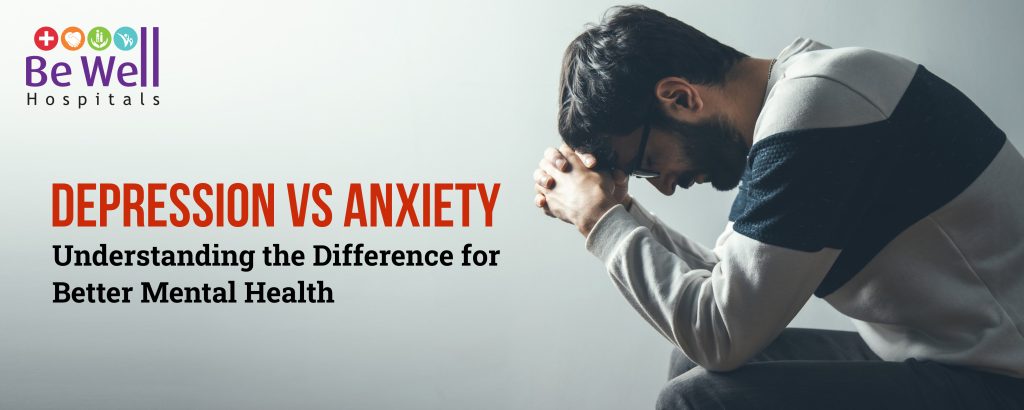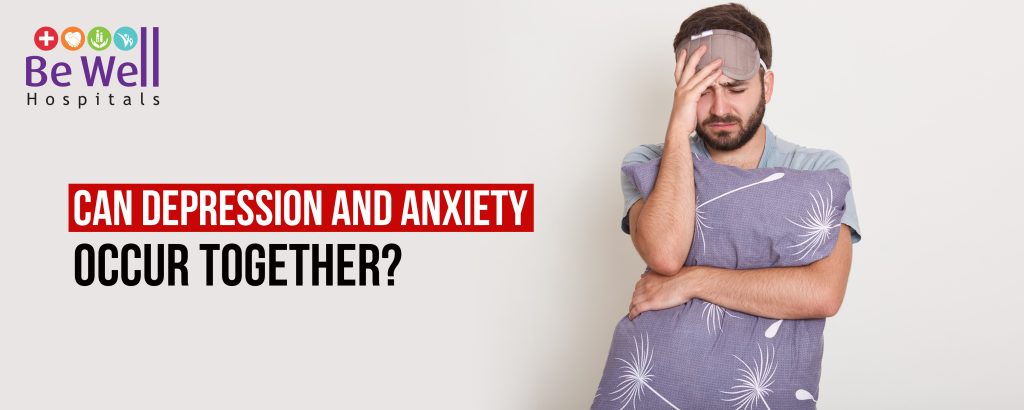
Introduction
In today’s fast-paced world, mental health challenges are becoming increasingly common—but not always well understood. Depression and anxiety are two of the most widespread mental health conditions. While they often occur together and share some similar symptoms, they are not the same. Depression brings persistent sadness and hopelessness, whereas anxiety causes constant fear and worry. Recognising the differences between them is crucial for accurate diagnosis, timely support, and effective treatment. In this blog, we explore the emotional, physical, and behavioural differences between depression and anxiety, how they affect daily life, and what you can do to support yourself or a loved one toward healing.
Understanding the Emotional and Physical Impact
Depression and anxiety affect the body and mind in distinct ways. Emotionally, depression can feel like a heavy fog—creating persistent sadness, emptiness, or a sense of worthlessness. It can sap motivation, make people lose interest in activities they once loved, and leave them feeling numb or isolated.
Anxiety, on the other hand, brings constant worry, uneasiness, or fear, often without a clear reason. It can make a person feel on edge, restless, or tense even during routine tasks. These emotional states can deeply influence how someone thinks, acts, and interacts with the world around them.
Physically, depression may lead to fatigue, poor appetite, or changes in sleep—often too much or too little. Individuals may move or speak more slowly, and everyday tasks may feel overwhelming. Anxiety typically triggers physical symptoms like rapid heartbeat, sweating, nausea, or stomach upset. People may also experience dizziness or difficulty sleeping due to racing thoughts. While the physical toll is real in both conditions, the symptoms often reflect the emotional patterns at play.
Different Types, Different Challenges
Mental health conditions are not one-size-fits-all. Depression and anxiety both include various types, each with unique features.
Here are some types of Depressive Disorders:
- Major Depressive Disorder (MDD): Characterised by intense sadness, fatigue, and disinterest in life for at least two weeks.
- Persistent Depressive Disorder (PDD): Long-term, low-grade depression lasting over two years.
- Seasonal Affective Disorder (SAD): Depression linked to seasonal changes, particularly during winter.
- Postpartum Depression: Affects women after childbirth, causing sadness, exhaustion, and anxiety.
- Premenstrual Dysphoric Disorder (PMDD): A severe form of PMS involving emotional and physical symptoms.
- Bipolar Disorder: Alternates between depressive lows and manic or hypomanic highs.
Here are some types of Anxiety Disorders:
- Generalized Anxiety Disorder (GAD): Chronic worry about everyday situations, even when there’s no apparent threat.
- Panic Disorder: Sudden, intense episodes of fear with physical symptoms like chest pain or shortness of breath.
- Social Anxiety Disorder: Deep fear of being judged or embarrassed in public settings.
- Specific Phobias: Extreme fear of particular objects or situations—like flying or heights.
- Separation Anxiety Disorder: Distress over being apart from loved ones, more common in children but also present in adults.
Each of these disorders requires unique treatment approaches, and understanding the differences helps healthcare providers personalise care.
Can Depression and Anxiety Occur Together?

Yes. Depression and anxiety often go hand in hand. Someone suffering from chronic anxiety may become overwhelmed, lose hope, and fall into depression. Similarly, a person battling long-term depression might develop anxiety over their health, relationships, or responsibilities. This combination—sometimes called comorbid depression and anxiety—is common and can intensify symptoms from both disorders.
Because the symptoms can overlap—such as trouble sleeping, fatigue, or difficulty concentrating—a proper diagnosis is essential. Mental health professionals use thorough evaluations to identify whether a person is dealing with one condition, both, or another related issue. Early diagnosis leads to more effective treatment and faster recovery.
Common Causes: What Triggers Depression and Anxiety?
Both depression and anxiety stem from a mix of biological, psychological, and social factors. These may include:
- Genetics: A family history of mental illness increases risk.
- Brain Chemistry: Imbalances in neurotransmitters like serotonin and dopamine affect mood regulation.
- Trauma: Events such as abuse, grief, or accidents can trigger emotional disorders.
- Personality Traits: Perfectionism, low self-esteem, or high sensitivity can contribute.
- Life Circumstances: Chronic stress from work, financial issues, or loneliness can wear down emotional resilience.
- Substance Use: Alcohol or drug abuse can worsen or cause mood issues.
- Medical Conditions: Hormonal changes, chronic pain, or certain medications can impact mental health.
Understanding the root cause helps guide the right combination of therapy, medication, and lifestyle changes.
Impact on Daily Life: A Hidden Struggle
Mental health conditions don’t just affect emotions—they influence every part of life.
- Work and Productivity: Both depression and anxiety make it harder to concentrate, stay motivated, or handle pressure. Individuals may take more sick days, miss deadlines, or avoid responsibilities.
- Social Interaction: People with depression may withdraw from relationships, feel disconnected, or lose interest in socialising. Anxiety can cause fear of judgment or embarrassment, leading to social avoidance.
- Physical Well-Being: Fatigue, digestive issues, insomnia, and headaches are common in both disorders. The emotional toll often manifests as physical symptoms, creating a cycle that worsens over time.
- Decision-Making and Self-Worth: Depression can diminish confidence and lead to indecisiveness. Anxiety may cause constant second-guessing and fear of making mistakes. Together, these challenges can deeply affect a person’s independence and sense of control.
Treatment Approaches: Finding the Right Support
Thankfully, depression and anxiety are treatable. A combination of therapies, lifestyle changes, and medical support often provides the best outcomes.
Here are some treatments for Depression:
- Therapy: Cognitive Behavioral Therapy (CBT) helps reframe negative thoughts and improve coping strategies.
- Medication: Antidepressants such as SSRIs can balance brain chemistry and lift mood.
- Lifestyle Changes: Exercise, sleep hygiene, and a nutritious diet support brain health.
- Support Systems: Talking to friends, family, or joining support groups reduces isolation.
- Mindfulness: Techniques like yoga, journaling, or meditation can calm the mind and improve emotional regulation.
Here are some treatments for Anxiety:
- Therapy: CBT and exposure therapy are particularly effective.
- Medication: Anti-anxiety drugs and some antidepressants help manage symptoms.
- Relaxation Techniques: Deep breathing, guided imagery, or progressive muscle relaxation reduce physical symptoms.
- Physical Activity: Regular movement helps reduce stress hormones and boost mood.
- Healthy Habits: Reducing caffeine, avoiding alcohol, and maintaining a consistent routine are key.
Each person’s recovery journey is unique. It’s important to work closely with a healthcare professional to create a treatment plan that fits personal needs and goals.
The Role of Family and Friends

A strong support system can make a huge difference. Here’s how loved ones can help:
- Listen without judgment—sometimes being present is the best gift.
- Encourage professional help and offer to assist with finding resources.
- Be patient with mood swings, cancellations, or emotional distance.
- Promote healthy habits through gentle encouragement.
- Avoid minimising their feelings—acknowledge their experience as real and valid.
- Offer practical help with daily tasks that may feel overwhelming.
- Stay connected—regular check-ins remind them they’re not alone.
Even small gestures of care can provide hope and motivation to those struggling with depression or anxiety.
Conclusion
Depression and anxiety affect millions of people—but they don’t have to define one’s life. Understanding the differences between the two helps identify the right support, treatment, and resources. Whether you or a loved one is dealing with persistent sadness or overwhelming worry, help is available—and healing is possible.
At Be Well Hospitals, we believe that mental health is just as important as physical health. Our team is here to support you with compassionate care, expert guidance, and personalised treatment plans. Let’s break the stigma, open up conversations, and create a healthier, more supportive world. Take the first step toward better mental wellness—call 9698 300 300 today or visit your nearest Be Well Hospitals.
